Beef sirloin
By JOE O'CONNELL, cbbqa Past
President
Updated September 28, 2001
Students of barbecue and grilling must
learn the differences among the different sections beef, such as the loin, short loin, tenderloin, sirloin, top sirloin, bottom sirloin, and
others. This will introduce the sirloin section, from which
several sirloin steaks and roasts are cut.
Introduction to the sirloin
The sirloin is the hip section of the beef, behind the short loin
section and in front of the round section. The sirloin comprises
several different muscles of the pelvic area, and each of these
different muscles of the sirloin have a different flavor and
tenderness. Some of the sirloin muscles can be cut into flavorful
and tender steaks and roasts, while others are not well-suited for
steaks or roasts but may be used in stews, for hamburger, and the like.
The meat from the sirloin section is much less expensive than that
from the short loin and rib section. Good quality sirloin steaks
and roasts, such as those described below, are excellent values.
Barbecue expert and author C. Clark "Smoky" Hale says,
"Perhaps the tastiest of the tender cuts of is the sirloin
steak." Hale at 99.
Location of the sirloin
The Beef Loin is what is called a "primal" section of beef,
and the Sirloin is a "sub-primal" section. The top
sirloin is one of the parts of the sirloin.
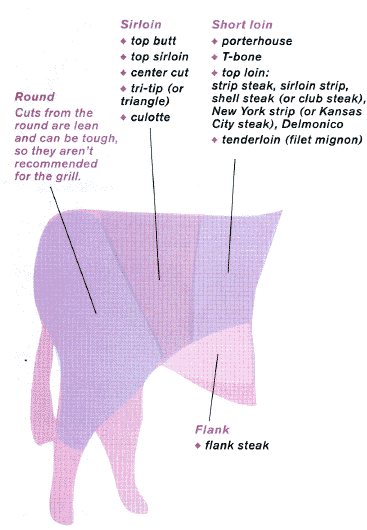
Butchering the sirloin
Butchering the sirloin from the beef carcass in North America follows
the USDA
Institutional Meat Purchase Specifications (IMPS). IMPS
identifies each cut of meat with a number. In the following
explanation, the IMPS number is shown in parentheses.
Starting with a side of beef (100), separate the hindquarter
(155). From the hindquarter (155), remove the primal section
called the round (158), and what remains is the primal section called
the full loin (172).
From the front ("anterior") section of the full loin (172),
separate the sub-primal short loin (173), including the 13th rib.
What remains is the sub-primal section called the sirloin (181), which
is the back ("posterior") section of the full loin (172).
The sirloin (181) includes three major muscles: the top sirloin
(181A), the sirloin butt (182) and the bottom sirloin butt (185).
As a steak, the top sirloin (181A) is flavorful but neither as
expensive nor as tender as steaks which come from the short loin (173,
which is where the filet mignon, tenderloin, New York, Porterhouse,
T-bone and other cuts are from).
The sirloin section produces four bone-in sirloin steaks. These
steaks are very good for grilling, with a strong, meaty flavor and
moderate tenderness.
Beef loin sirloin steaks, bone in
The proper name for the sirloin is the Beef Loin Sirloin.
The following paragraphs describes the four bone-in sirloin steaks,
which are cut from the beef loin sirloin primal cut.
Pin bone sirloin steak
The Beef Loin Sirloin Steak, Pin Bone (which is the correct
and proper name of this cut) sits next to the porterhouse and has a
piece of the tenderloin muscle. In the photograph below, the three
larges muscle groups are:
- in the upper half, there are several muscles including:
the half-circlular muscle in the top center, which is the top
sirloin (Gluteus medius); under it, the
square-looking muscle is the strip (Longissimus); and
above it, in the upper right, is the small mushroom-shaped Multifidus
dorsi;
- in the lower center, the tenderloin (Psoas major);
and
- on the far left, the flap (Obliquus abdominis interni).
UNLM at Cross-section I.
This cut is the most tender and desirable
of the four, bone-in sirloin steaks. Hale at 77.
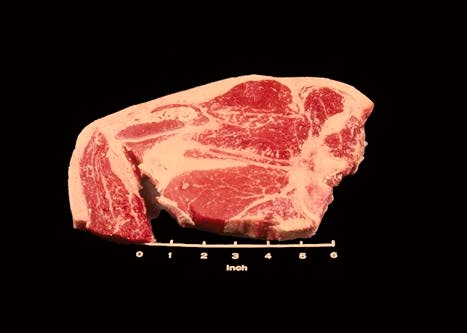
The pin bone sirloin steak is an excellent steak, in terms of flavor
and tenderness.
Note for barbecue veterans: because the public
does not know the difference in the quality of these cuts, a 2"
thick, USDA Prime Grade pin bone sirloin can be found on sale at a
very low price.
Behind the pin bone sirloin is the Beef Loin Sirloin Steak, Flat
Bone (which is the correct and proper name of this cut), which
contains the most bone, compared with the other sirloin steaks. In
the photograph below, the four large muscles are:
- the round muscle on the lower right, the tenderloin (Psoas
major);
- the largest curved muscle in the upper center, the top sirloin (Gluteus
medius);
- the smaller curved muscle on the upper left, the flap (Obliquus
abdominis interni); and
- the smallest, round muscle on the middle left, a portion of the
tri-tip (Tensor fasciae latae).
UNLM at Cross-section F.
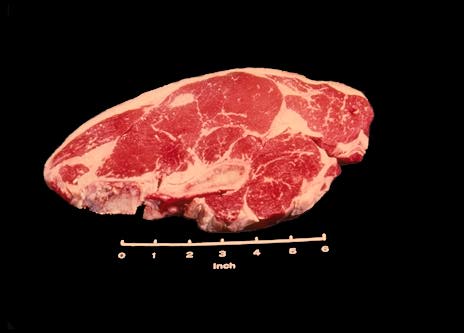
This is the least valuable of the sirloin steaks, if both the flat
hip and backbones are left in the steak, but the flavor and tenderness
of the meat are second only to that of the pin bone sirloin.
Round bone sirloin steak
Behind the flat bone sirloin is the Beef Loin Sirloin Steak, Round
Bone (which is the correct and proper name of this cut). In
the photograph below, the four large muscles are:
- on the lower left, the tenderloin (Psoas major);
- the largest curved muscle in the center, the top sirloin (Gluteus
medius);
- the smaller curved muscle on the right, the bottom round (Biceps
femoris); and
- the smaller muscle on the upper left is a portion of the tri-tip
(Tensor fasciae latae).
UNLM at Cross-section
D.
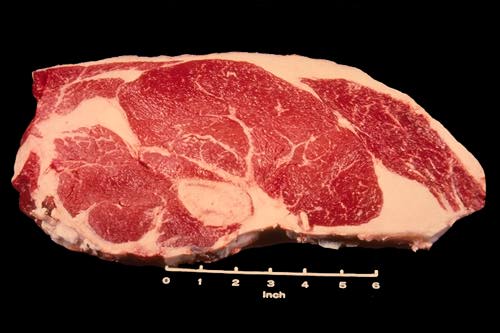
The round bone sirloin steak has the greatest
amount of lean and the least amount of bone, compared with the other
bone-in sirloin steaks.
Wedge bone sirloin steak
Behind the round bone sirloin is the Beef Loin Sirloin Steak,
Wedge Bone (which is the correct and proper name of this cut).
In the photograph below, the four larges muscles are:
- on the lower left, the tenderloin (Psoas major);
- the largest curved muscle in the center, the top sirloin (Gluteus
medius);
- the smaller curved muscle on the right, the bottom round (Biceps
femoris); and
- the smaller muscle on the upper left is a portion of the tri-tip
(Tensor fasciae latae).
UNLM at Cross-section
B.
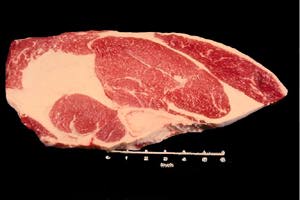
In this cut, there is usually only a single
bone, which is the wedge-shaped bone at the bottom of the cut near the
center.
Beef loin sirloin steaks, boneless
The Beef Loin Sirloin Steak, Boneless is
an excellent steak for broiling and is made by removing all of the bones
from any of the other types of sirloin steaks. UNL. Various names are
given to these steaks, and they are described below.
The Beef loin, top sirloin (181) produces several four primary boneless sirloin
steaks:
- Beef loin, top sirloin (181A)
- Beef loin, sirloin butt (182)
- Beef loin, top sirloin butt (184)
- Beef loin, bottom sirloin butt (185)
- Beef loin, bottom sirloin butt, tri-tip (185C).
Like
the four bone-in sirloin steaks, these five boneless sirloin steaks are good for
grilling, with a strong, meaty flavor and moderate tenderness.
The IMPS name for this is the Beef loin, top sirloin
(181A). The top sirloin steak is pictured above. The steak
was trimmed from the flat bone sirloin steak (an
untrimmed version is pictured above).
In the photograph below, the two largest muscles
are:
- the largest curved muscle in the center, the top sirloin (Gluteus
medius); and
- the smaller curved muscle on the upper right, the bottom round (Biceps
femoris).
UNLM at Cross-section F.
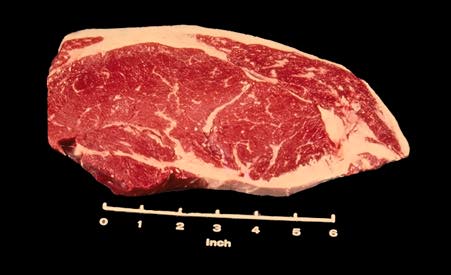
According to Smoky Hale, the boneless top sirloin steak is also
called sirloin strip, New York strip (in the West), Kansas City strip
(in the East). Hale at 99.
Note: This demonstrates the problem with beef
terminology, since the term New York strip is used by some to
mean a boneless top sirloin steak and by others to mean a for a
boneless top loin steak (which have a substantial difference in
price). See, e.g., the related article
on the use of the term for a Delmonico steak.
Sirloin butt steak
The IMPS name for this is the Beef loin, sirloin butt (182)
Top sirloin butt steak
The IMPS name for this is the Beef loin, top sirloin butt
(184).
Bottom sirloin butt steak
The IMPS name for this is the Beef loin, bottom sirloin butt
(185).
Tri-tip sirloin steak
The IMPS name for this is Beef loin, bottom sirloin butt, tri-tip
(185C). The tri-tip is the tensor fasciae latae muscle.
Sometimes called the culotte, the tri-tip is a relatively new cut,
"discovered" at Santa Maria, California in the 1950s.
[insert cite] The tri-tip in
California is usually not cut as a steak but as a roast, and it is
grilled with a special rub.
The tri-tip may be called a "sirloin tip" (see Hale at 77) and is the triangular
portion of the bottom sirloin butt.
Related topics:
|